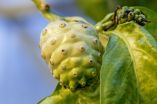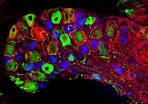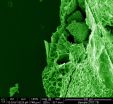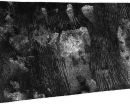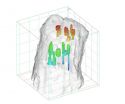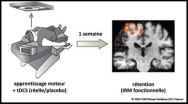Toxic fruits hold the key to reproductive success
2014-12-09
This news release is available in German.
In the course of evolution, animals have become adapted to certain food sources, sometimes even to plants or to fruits that are actually toxic. The driving forces behind such adaptive mechanisms are often unknown. Scientists at the Max Planck Institute for Chemical Ecology in Jena, Germany, have now discovered why the fruit fly Drosophila sechellia is adapted to the toxic fruits of the morinda tree. Drosophila sechellia females, which lay their eggs on these fruits, carry a mutation in a gene that inhibits egg production. ...
Stain every nerve
2014-12-09
Scientists can now explore nerves in mice in much greater detail than ever before, thanks to an approach developed by scientists at the European Molecular Biology Laboratory (EMBL) in Monterotondo, Italy. The work, published online today in Nature Methods, enables researchers to easily use artificial tags, broadening the range of what they can study and vastly increasing image resolution.
"Already we've been able to see things that we couldn't see before," says Paul Heppenstall from EMBL, who led the research. "Structures such as nerves arranged around a hair on the skin; ...
New treatment strategy for epilepsy
2014-12-09
Researchers found out that the conformational defect in a specific protein causes Autosomal Dominant Lateral Temporal Lobe Epilepsy (ADLTE) which is a form of familial epilepsy. They showed that treatment with chemical corrector called "chemical chaperone" ameliorates increased seizure susceptibility in a mouse model of human epilepsy by correcting the conformational defect. This was published in Nature Medicine (December 8, 2014 electronic edition).
Mutations in the gene LGI1, encoding a secreted protein, cause familial temporal lobe epilepsy. The research group of ...
Turning biological cells to stone improves cancer and stem cell research
2014-12-09
ALBUQUERQUE, N.M. -- Changing flesh to stone sounds like the work of a witch in a fairy tale.
But a new technique to transmute living cells into more permanent materials that defy rot and can endure high-powered probes is widening research opportunities for biologists who are developing cancer treatments, tracking stem cell evolution or even trying to understand how spiders vary the quality of the silk they spin.
The simple, silica-based method also offers materials scientists the ability to "fix" small biological entities like red blood cells into more commercially ...
The winds of Titan
2014-12-09
As sand dunes march across the Sahara, vast dunes cross the surface of Saturn's largest moon, Titan. New research from a refurbished NASA wind tunnel reveals the physics of how particles move in Titan's methane-laden winds and could help to explain why Titan's dunes form in the way they do. The work is published online Dec. 8 in the journal Nature.
"Conditions on Earth seem natural to us, but models from Earth won't work elsewhere," said Bruce White, professor of mechanical and aerospace engineering at the University of California, Davis, and a co-author on the study. ...
Smoking still causes large proportion of cancer deaths in the United States
2014-12-09
ATLANTA - December 9, 2014- A new American Cancer Society study finds that despite significant drops in smoking rates, cigarettes continue to cause about three in ten cancer deaths in the United States. The study, appearing in the Annals of Epidemiology, concludes that efforts to reduce smoking prevalence as rapidly as possible should be a top priority for the U.S. public health efforts to prevent cancer deaths.
More than 30 years ago, a groundbreaking analysis by famed British researchers, Richard Doll and Richard Peto, calculated that 30 percent of all cancer deaths ...
Paying attention makes touch-sensing brain cells fire rapidly and in sync
2014-12-09
Whether we're paying attention to something we see can be discerned by monitoring the firings of specific groups of brain cells. Now, new work from Johns Hopkins shows that the same holds true for the sense of touch. The study brings researchers closer to understanding how animals' thoughts and feelings affect their perception of external stimuli.
The results were published Nov. 25 in the journal PLoS Biology.
"There is so much information available in the world that we cannot process it all," says Ernst Niebur, Ph.D., a professor of neuroscience in the Johns Hopkins ...
Storing hydrogen underground could boost transportation, energy security
2014-12-09
LIVERMORE, Calif. -- Large-scale storage of low-pressure, gaseous hydrogen in salt caverns and other underground sites for transportation fuel and grid-scale energy applications offers several advantages over above-ground storage, says a recent Sandia National Laboratories study sponsored by the Department of Energy's Fuel Cell Technologies Office.
Geologic storage of hydrogen gas could make it possible to produce and distribute large quantities of hydrogen fuel for the growing fuel cell electric vehicle market, the researchers concluded.
Geologic storage solutions ...
Stroke: Promising results of an important study published in the scientific journal Brain
2014-12-09
Neuro-rehabilitation (physical therapy, occupational therapy, etc.) helps hemaparetic stroke patients confronted with loss of motor skills on one side of their body, to recover some of their motor functions after a cerebrovascular accident. One of the most promising tracks in neuro-rehabilitation consists in amplifying the motor learning ability after a stroke, in other words how to learn (again) how to make movements with the parts of the human body impacted after a stroke.
Pilot studies have shown at this matter that tDCS (transcranial direct current stimulation) - ...
Ancient balloon-shaped animal fossil sheds light on Earth's ancient seas
2014-12-09
Nidelric pugio fossil dates to half a billion years ago and teaches us about the diversity of life in Earth's ancient seas
In life the animal was a 'balloon' shape and was covered in spines, but the squashed fossil resembles a bird's nest
Named in honour of Professor Richard Aldridge from the University of Leicester
A rare 520 million year old fossil shaped like a 'squashed bird's nest' that will help to shed new light on life within Earth's ancient seas has been discovered in China by an international research team - and will honour the memory of a University of ...
Data published on ANG4043, anti-HER2 monoclonal antibody for treatment of brain metastases
2014-12-09
Montreal, Canada, November x, 2014 - Angiochem, a clinical stage biotechnology company creating and developing drugs that cross the blood-brain barrier, today announced the publication in Molecular Cancer Therapeutics demonstrating that ANG4043, a peptide-monoclonal antibody (mAb) conjugate, entered the brain at therapeutic concentrations, resulting in significantly prolonged survival in mice. The antibody is directed against HER2, which is the protein targeted by Herceptin®. Because the mAb is conjugated to Angiopep-2, it is recognized by the LRP1 receptor and takes ...
Sleep disturbance linked to amyloid in brain areas affected by Alzheimer's disease
2014-12-09
Phoenix, AZ (December 9th, 2014) - Healthy, elderly research participants who report being more sleepy and less rested have higher levels of amyloid deposition in regions of the brain that are affected in Alzheimer's disease, according to a report presented today at the American College of Neuropsychopharmacology annual meeting in Phoenix (Arizona). If sleep disturbance is a cause of amyloid accumulation, it may be an early target for intervention to prevent the progression of cognitive deficits in late life.
Numerous studies have shown the importance of sleep and the ...
Brain scans link frontal abnormalities to suicidal behaviors in adolescents, young adults
2014-12-09
Phoenix, AZ (December 9th, 2014) - Abnormalities in the prefrontal cortex and related brain areas are observed in adolescents who have attempted suicide, according to a report today at the American College of Neuropsychopharmacology annual meeting in Phoenix Arizona. The study suggests that deficits in frontal systems may be associated with risk for suicide attempts in youths with mood disorders.
Most suicide attempts occur in the context of mood disorders, including bipolar disorder and major depressive disorder. Bipolar disorder has a prevalence of 3-4% in the U.S. population, ...
Immunotherapy shows clinical benefit in relapsed transplant recipients
2014-12-09
A multicenter phase 1 trial of the immune checkpoint blocker ipilimumab found clinical benefit in nearly half of blood cancer patients who had relapsed following allogeneic stem cell transplantation, according to investigators from Dana-Farber Cancer Institute, who developed and lead the study.
The study reported at the American Society of Hematology annual meeting is the first in which ipilimumab was given in multiple doses over an extended time period, the researchers said.
At a median follow-up time of six months, "We have seen less toxicity than expected and a strong ...
PRM-151 therapy well tolerated in patients with advanced myelofibrosis
2014-12-09
A study that investigated the potential of the compound PRM-151 (PRM) for reducing progressive bone marrow fibrosis (scarring) in patients with advanced myelofibrosis has shown initial positive results. Myelofibrosis is a life-threatening bone marrow cancer.
The study, led by Srdan Verstovsek, M.D., Ph.D., professor of leukemia at The University of Texas MD Anderson Cancer Center, showed the compound was well tolerated in observing 27 patients. Verstovsek's research results were presented today at the 56th Annual Meeting of the American Society of Hematology (ASH) annual ...
Improving health through smarter cities: Debut of a major new global science collaboration
2014-12-09
Aiming to empower planners and policy-makers to achieve better health for billions of people living in fast-growing urban areas, world health, environmental, behavioural and social science experts today launched a major new interdisciplinary scientific collaboration.
Programme goals:
Empowering planners and policy-makers with better science to create healthy urban environments and improve wellbeing;
Identify and manage unintended health consequences of urban policy;
Understand connections between cities and planetary change
Leading the consortium of science ...
Debate on safety of e-cigarettes continues
2014-12-09
Opposing views on the potential impact of electronic cigarettes on public health are published in the open access journal BMC Medicine. The commentaries, by two experts, differ in their views on the topic but are united in their call for a rational discussion based on evidence.
The authors examine the WHO's recommendations earlier this year. One recommendation was that smokers should not use e-cigarettes and has now been withdrawn, and the other is that policymakers should implement their strict regulation, which is still in force.
In one of the commentaries, Peter ...
Heart disease patients advised to avoid being outside in rush hour traffic
2014-12-09
Sophia Antipolis, 09 December 2014: Heart disease patients have been advised to avoid being outside during rush hour traffic in a paper published today in European Heart Journal.1 The position paper on air pollution and cardiovascular disease was written by experts from the European Society of Cardiology and also recommends decreasing the use of fossil fuels.
Professor Robert F. Storey, corresponding author of the paper, said: "More than 3 million deaths worldwide are caused by air pollution each year. Air pollution ranks ninth among the modifiable disease risk factors, ...
Combining insecticide sprays and bed nets 'no more effective' in cutting malaria
2014-12-09
There is no need to spray insecticide on walls for malaria control when people sleep under treated bed nets, according to new research.
Use of insecticide sprayed on internal walls, when combined with insecticide-treated bed nets in homes, does not protect children from malaria any more effectively than using just insecticide-treated bed nets, the research led by Durham University and the Medical Research Council's Unit in The Gambia found.
The researchers said this was important as insecticide-treated nets and insecticide sprayed on walls are commonly used for controlling ...
Pricing for new drugs lacks transparency
2014-12-09
The system that allows patients rapid access to expensive new treatments lacks transparency and penalises small and low-income countries unable to negotiate lower prices with pharmaceutical manufacturers. Writing in the Journal of the Royal Society of Medicine, the authors of an essay on market-access agreements for anti-cancer drugs, say that while the underlying strategy is to help reduce the likelihood of health systems paying for treatments that turn out not to be cost-effective, the agreements can also be seen as an opportunistic way for pharmaceutical manufacturers ...
Wealth, power or lack thereof at heart of many mental disorders
2014-12-09
Donald Trump's ego may be the size of his financial empire, but that doesn't mean he's the picture of mental health. The same can be said about the self-esteem of people who are living from paycheck to paycheck, or unemployed. New research from the University of California, Berkeley, underscores this mind-wallet connection.
UC Berkeley researchers have linked inflated or deflated feelings of self-worth to such afflictions as bipolar disorder, narcissistic personality disorder, anxiety and depression, providing yet more evidence that the widening gulf between rich and ...
The Lancet: Combining insecticide spraying and bed nets no more protective against malaria than nets alone
2014-12-09
The combined use of spraying insecticide inside homes and insecticide-treated bed nets is no better at protecting children against malaria than using bed nets alone, a study in The Gambia suggests. The findings, published in The Lancet, should encourage donors to invest their limited resources in additional bed nets, the more cost-effective solution to tackling malaria*.
Lead author Professor Steve Lindsay, a disease ecologist at Durham University in the UK explains, "Our findings do not support any universal recommendation for indoor residual spraying as an addition ...
Blocking receptor in brain's immune cells counters Alzheimer's in mice
2014-12-09
The mass die-off of nerve cells in the brains of people with Alzheimer's disease may largely occur because an entirely different class of brain cells, called microglia, begin to fall down on the job, according to a new study by researchers at the Stanford University School of Medicine.
The researchers found that, in mice, blocking the action of a single molecule on the surface of microglia restored the cells' ability to get the job done -- and reversed memory loss and myriad other Alzheimer's-like features in the animals.
The study, to be published online Dec. 8 in ...
News from Annals of Internal Medicine Dec. 8, 2014
2014-12-09
1. Breast density notification laws substantially increase costs yet save few lives
Laws requiring women to be notified of their breast density so that they may discuss supplemental screening options, including ultrasound, with their health care providers would substantially increase costs and save relatively few lives, according to an article published in Annals of Internal Medicine. More than 40 percent of women between the ages of 40 and 74 have dense breast tissue, which puts them at increased risk for breast cancer and affects how well a mammogram can detect abnormalities. ...
Major complications after abortion are extremely rare, study shows
2014-12-09
In the most comprehensive look yet at the safety of abortion, researchers at UC San Francisco have concluded that major complications are rare, occurring less than a quarter of a percent of the time, about the same frequency as colonoscopies.
The study, published online on Monday, Dec. 8, 2014, in Obstetrics & Gynecology, analyzed data from more than 50,000 women enrolled in the Medi-Cal fee-for-service program who obtained abortions from 2009 to 2010, and looked for complications that occurred within six weeks of the procedure.
The rate is similar to what has been ...
[1] ... [3023]
[3024]
[3025]
[3026]
[3027]
[3028]
[3029]
[3030]
3031
[3032]
[3033]
[3034]
[3035]
[3036]
[3037]
[3038]
[3039]
... [8709]
Press-News.org - Free Press Release Distribution service.
